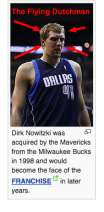Jonathan Christian
For my article I decided to research the Wikipedia page of the Dallas Mavericks, a professional sports team that I have been following closely since my childhood. In reviewing the page history of the article after having re-familiarized myself with some of the team’s history, I came to find it truly interesting how humankind’s ability to network worldwide has come to affect a new understanding of our concept of “collective intelligence”. Collective intelligence, as defined by Jenkins in his article, is achieved by “the ability to pool knowledge and compare notes with others towards a common goal.”(1) Being that we now live in a digital age where communication can be transmitted almost anywhere in the world in an instant across the internet, I believe that in my experience I witnessed a much more honest, less-biased, and open dialogue in this atmosphere of “participatory culture” than would have been represented by some clandestine group that claimed to know absolute truth about the matter in hand but wished to share nothing that provided any source of material for evidence except one text published by themselves. Allusions to organized religious indoctrination aside, I believe this new form of transdigital cooperation is an extremely utile way for us to disseminate information to each other through online negotiation, or “the ability to travel across diverse communities, discerning and respecting multiple perspectives, and grasping and following alternative viewpoints” (1), even if their view don’t disagree with our own. I experienced these principles with greater reaffirmation when I further delved into the “view history” option of that Dallas Mavericks wiki. The reason I say this, is when one reviews the editing of the Mavericks, it becomes immediately apparent that not only is the page being edited by a multitude of aficionados and die-hard sports critics, but the frequency with which it is edited to add even the most minor of details, sometimes peaking with dozens of edits a day when something as monumental as trades, injuries, or championships become prevalent. “The ability to evaluate the reliability and credibility of [these] different information source[s]”, or judgment (1), in this system is met with little criticism or doubt for one, or possible two, reasons. The primary factor for this is that with games streaming live over all media and a facet of NBA driven apps for smartphones and the like being readily available, the game is centered around not only live video coverage but also up-to-the minute statistics that is difficult even in a community of collective intelligence to misreport. The second and more ancillary reason, and perhaps what makes sports-watchers far more fortuitous than their gaming on other online counterparts, is that internet “trolls” have far less interest and ability to foment insurrection and discord among this sort of community due to the audience’s fixation on the game as it is happening in the moment and one typically does not telecast with complete strangers during the game as they would with something such as “Call of Duty”.
(Although dates and text is blurry (unsure as to exatly why here), this is meant to show the degree to which the site is updated with a certain degree of hype building up before, and existing during as well as after the game)
Jenkins, Henry. “What Wikipedia Can Teach Us About the New Media Literacies (Part One). Confessions of an AcaFan. Henry Jenkins, n.d.

